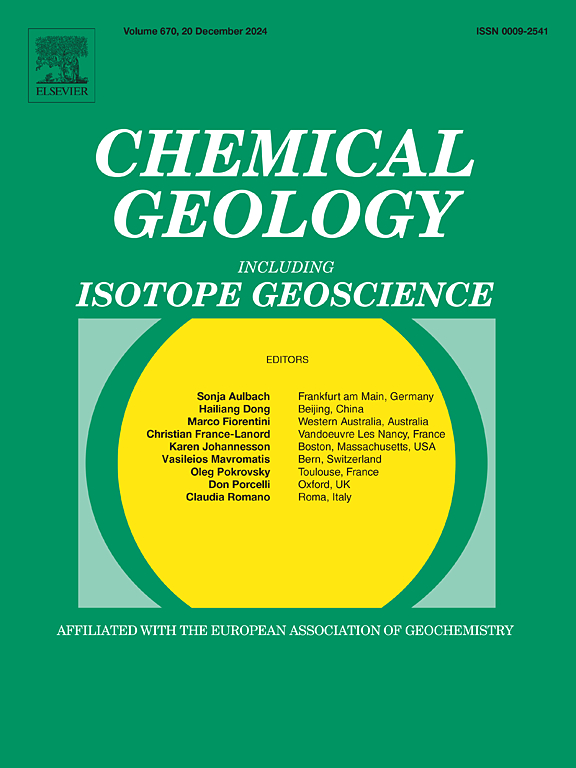南卡罗莱纳州溶蚀岩风化过程中记录的稀土元素(REE)极度富集现象
IF 3.6
2区 地球科学
Q1 GEOCHEMISTRY & GEOPHYSICS
引用次数: 0
摘要
南卡罗莱纳Cayce变质岩脉腐殖岩中稀土元素(REE)和其他微量元素浓度以及143Nd/144Nd和87Sr/86Sr记录了化学风化过程中稀土元素的极端运移和稀土元素在粘土上的富集。腐殖岩总REE浓度(ΣREE)和轻REE (LREE)/重REE (HREE)比值呈双峰型分布。浅层(0 ~ 6 m深)I类腐殖岩ΣREE含量高(可达2633 ppm),富集LREE >;MREE祝辞深入分析。II组腐辉岩的ΣREE值较低(45 ~ 67 ppm), LREE/HREE值相对较低,与未风化的变质辉绿岩相似。ⅰ组腐腐岩风化程度较好(蚀变化学指数(CIA)为87 ~ 95),ⅱ组腐腐岩风化程度较好(CIA = 46 ~ 88,大部分为55)。利用143Nd/144Nd进行的质量平衡计算排除了大量灰尘对风化剖面的输入,这与εNd缺乏深度相关的变化是一致的。风化和稀土富集经历了三个阶段。第1阶段为区域风化阶段,变质辉绿岩岩脉和自由山花岗岩乡村岩石均发育腐殖岩。在这一阶段,花岗岩中富含稀土元素的副矿物(如钛矿)的分解释放出稀土元素和放射性成因的锶元素,这些元素被风化流体渗透到偏辉绿岩中,并被吸附到粘土上,与它们的Nd和Sr同位素组成一致。II类腐岩中高岭石/蒙脱石(K/S)比值与Sm/Nd呈负相关,与Y/Ho和Rb/Sr呈正相关,说明高岭石优先吸附较轻的REE(如Nd)、Y和Rb;在第一组腐腐岩中没有发现任何趋势,这表明这些样本被后来的事件覆盖,而这些事件没有影响第二组腐腐岩。第二阶段是在高pH值和沼泽等还原性条件下,整个腐岩中的蒙脱石脉被菱铁矿取代,这并不影响粘土中吸附的REE。在第3阶段,在酸性和氧化条件下,菱铁矿在最浅深度(上部2 m)溶解,形成了Fe3+-蒙脱石,并活化了LREE;这种含稀土流体向下渗透,稀土元素被吸附到粘土上,在上部6 m (I组腐殖岩内)局部形成稀土富集带。碳酸盐岩也可能作为沉积配体并诱发稀土元素沉淀。研究表明,在特定条件下,稀土元素在化学风化过程中具有极强的流动性,并可能沉积在高岭石等次生粘土矿物上,高岭石等次生粘土矿物吸收稀土元素,特别是轻稀土元素,导致局部富集。本文章由计算机程序翻译,如有差异,请以英文原文为准。
Extreme rare earth element (REE) enrichment during weathering recorded in saprolites from South Carolina
Rare earth elements (REE) and other trace element concentrations as well as 143Nd/144Nd and 87Sr/86Sr in saprolites developed on the Cayce metadiabase dike, South Carolina, document extreme REE mobilization during chemical weathering and enrichment of REE on clays. Saprolites display a bimodal distribution in their total REE concentrations (ΣREE) and light-REE (LREE)/heavy-REE (HREE) ratios. Shallower (0–6 m depth), Group I, saprolites have high ΣREE (up to 2633 ppm) with enrichment of LREE > MREE > HREE. Group II saprolites, at >6 m depth, have lower ΣREE (45–67 ppm) and relatively flat LREE/HREE, similar to the unweathered metadiabase. Group I saprolites are more weathered (chemical index of alteration (CIA) values of 87–95), than the Group II saprolites (CIA = 46–88, with most <55). Mass balance calculations using 143Nd/144Nd rules out significant input of dust to the weathering profile, which is consistent with the lack of depth-dependent variation in εNd. Weathering and REE enrichment occurred through a three-stage process. Stage 1 involved regional weathering during which saprolites developed on both the metadiabase dike and Liberty Hill granite country rock. During this stage, breakdown of LREE-rich accessory minerals (e.g., titanite) in the granite released REE and radiogenic Sr to weathering fluids that penetrated the metadiabase where these elements were adsorbed onto clays, consistent with their Nd and Sr isotopic compositions. The kaolinite/smectite (K/S) ratio in Group II saprolites negatively correlates with Sm/Nd and positively with Y/Ho and Rb/Sr ratios indicating preferential adsorption of lighter REE (e.g., Nd), Y, and Rb by kaolinites; no trends are seen in Group I saprolites, suggesting that these samples were overprinted by later events that did not impact the Group II saprolites. Stage 2 involved replacement of smectite veins by siderite in the entire saprolite at high pH and under reducing conditions such as found in swamps, which did not affect the adsorbed REE in the clays. In stage 3, siderite dissolution under acidic and oxidized conditions at the shallowest depths (upper 2 m) led to the formation of Fe3+-smectite and LREE mobilization; this REE-bearing fluid percolated downwards where the REE were adsorbed onto clays to develop a REE-enriched zone locally in the upper 6 m (within the Group I saprolites). Carbonates may have also acted as depositional ligands and induced REE precipitation. This study shows that REE can be extremely mobile during chemical weathering under specific conditions and may be deposited onto secondary clay minerals like kaolinites, which absorb REE, particularly LREE, leading to local enrichments.
求助全文
通过发布文献求助,成功后即可免费获取论文全文。
去求助
来源期刊

Chemical Geology
地学-地球化学与地球物理
CiteScore
7.20
自引率
10.30%
发文量
374
审稿时长
3.6 months
期刊介绍:
Chemical Geology is an international journal that publishes original research papers on isotopic and elemental geochemistry, geochronology and cosmochemistry.
The Journal focuses on chemical processes in igneous, metamorphic, and sedimentary petrology, low- and high-temperature aqueous solutions, biogeochemistry, the environment and cosmochemistry.
Papers that are field, experimentally, or computationally based are appropriate if they are of broad international interest. The Journal generally does not publish papers that are primarily of regional or local interest, or which are primarily focused on remediation and applied geochemistry.
The Journal also welcomes innovative papers dealing with significant analytical advances that are of wide interest in the community and extend significantly beyond the scope of what would be included in the methods section of a standard research paper.
 求助内容:
求助内容: 应助结果提醒方式:
应助结果提醒方式:


